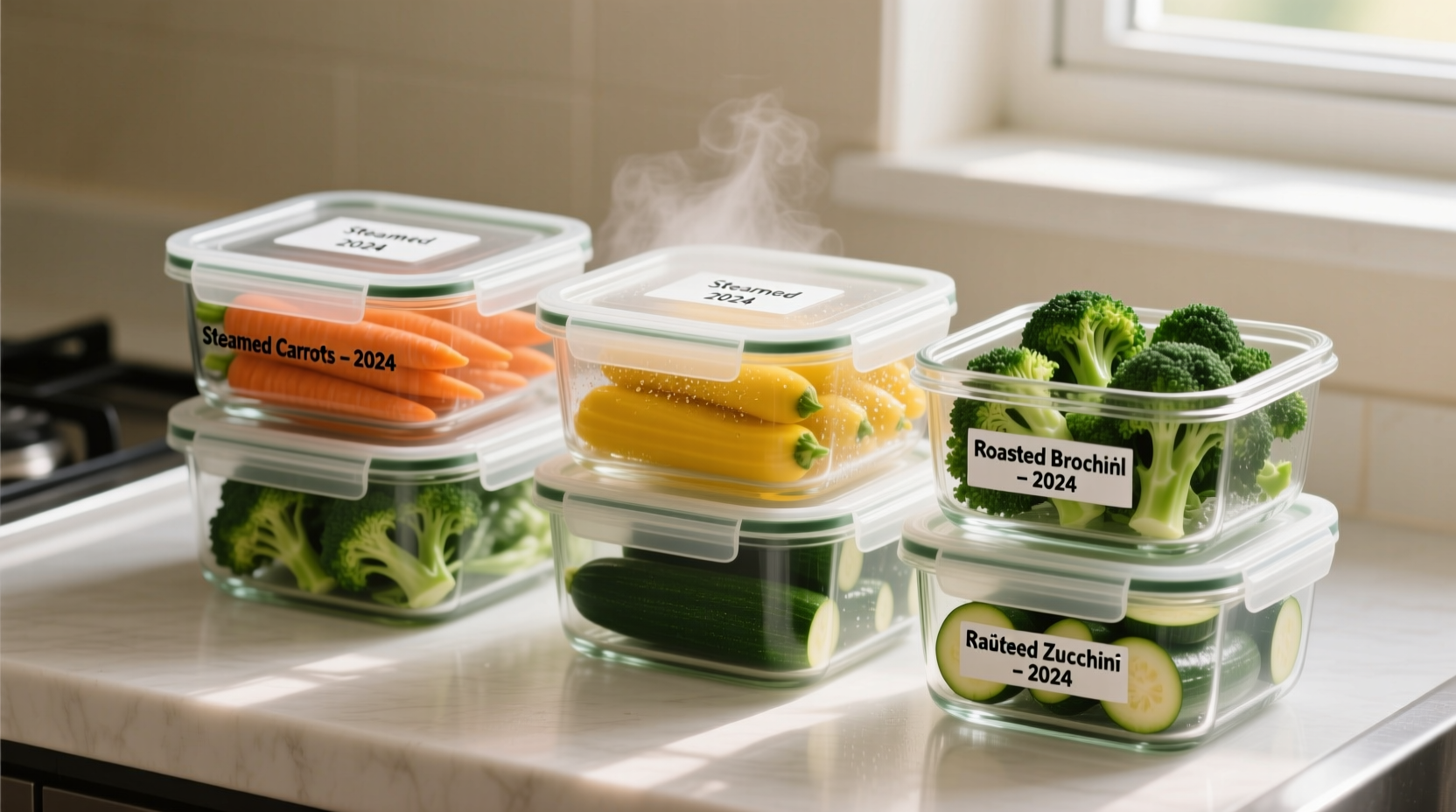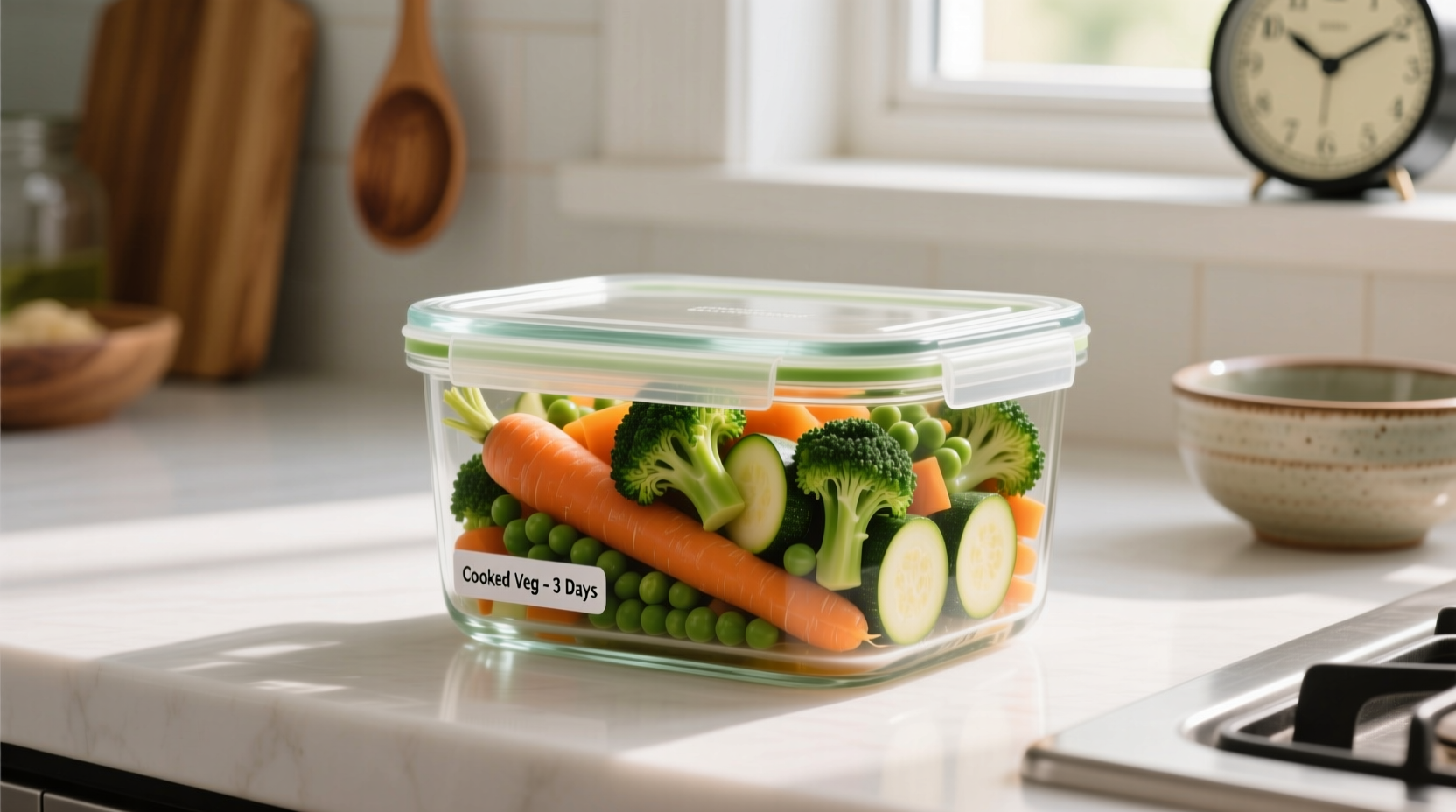Most cooked vegetables stay fresh and safe in the refrigerator for 3–5 days when stored properly at or below 40°F (4°C). This timeframe applies to common vegetables like broccoli, carrots, and green beans. Starchy vegetables like potatoes may last slightly longer, while delicate greens like spinach spoil faster.
Wondering if those leftover roasted vegetables from dinner are still safe to eat today? You're not alone. Every year, millions of households face this exact question while trying to balance food safety with reducing waste. Getting this right matters more than you might think — improper storage of cooked vegetables leads to unnecessary food waste and potential foodborne illness.
Understanding Cooked Vegetable Shelf Life
When you search "how long do cooked vegetables last in the fridge," you need more than just a number. You need context about what affects that timeline and how to maximize freshness. The standard 3–5 day guideline comes from the USDA Food Safety and Inspection Service, but several factors can shorten or extend this window.
How Long Different Cooked Vegetables Last
Not all vegetables behave the same in the refrigerator. Here's a detailed breakdown of shelf life for common cooked vegetables:
| Vegetable Type | Refrigerator Shelf Life | Special Considerations |
|---|---|---|
| Cruciferous (broccoli, cauliflower) | 3–4 days | May develop stronger odor as they age |
| Root vegetables (carrots, beets) | 4–5 days | Store in airtight container with minimal moisture |
| Leafy greens (spinach, kale) | 2–3 days | Wilt quickly; discard at first sign of sliminess |
| Starchy vegetables (potatoes, corn) | 5–7 days | May develop sweeter taste as they age |
| Squash and zucchini | 3–4 days | Discard if becomes mushy or develops mold |
4 Key Factors That Affect Shelf Life
The standard 3–5 day rule isn't set in stone. These factors determine whether your cooked vegetables will last closer to 3 days or push toward 5:
1. Cooling Speed After Cooking
The FDA FoodKeeper app emphasizes that how quickly you cool cooked vegetables dramatically impacts safety. Never leave cooked vegetables at room temperature for more than 2 hours (1 hour if your kitchen is above 90°F/32°C). Rapid cooling preserves texture and prevents bacterial growth.
2. Storage Container Quality
Airtight containers significantly extend freshness. Glass containers with tight seals work best, maintaining optimal humidity levels. Avoid storing leftovers in the original cooking pan, which doesn't provide proper protection from moisture loss and odor absorption.

3. Refrigerator Temperature Consistency
Your refrigerator must maintain a consistent temperature at or below 40°F (4°C). Fluctuations above this threshold accelerate spoilage. Use an independent thermometer to verify your fridge's actual temperature, as built-in displays can be inaccurate.
4. Initial Vegetable Quality
Fresher vegetables before cooking generally last longer after cooking. Vegetables that were already starting to wilt before cooking won't maintain quality as long in the refrigerator.
Maximizing Freshness: Practical Storage Tips
Follow these chef-tested techniques to get the most out of your cooked vegetable leftovers:
- Portion control — Divide large batches into single-serving containers to avoid repeatedly opening and closing the same container
- Moisture management — Place a paper towel in the container with vegetables prone to sogginess like zucchini or eggplant
- Strategic placement — Store leftovers on middle shelves where temperature is most consistent, not in the door where temperatures fluctuate
- Label everything — Use masking tape to note cooking date on containers
When to Toss Leftovers: Safety First
Don't rely solely on the calendar. Always inspect leftovers for these signs of spoilage before consuming:
- Mold growth — Any visible mold means discard the entire container (mold roots penetrate deeper than visible)
- Off odors — Sour, fermented, or generally unpleasant smells indicate bacterial growth
- Texture changes — Sliminess, excessive mushiness, or unusual stickiness
- Color changes — Significant darkening or unusual discoloration beyond normal oxidation
When in doubt, throw it out. The USDA emphasizes that foodborne pathogens often don't produce noticeable changes in food. If you're uncertain about safety, it's better to waste food than risk illness.
Reheating Leftover Vegetables Safely
Proper reheating is the final safety step. Always heat cooked vegetables to an internal temperature of 165°F (74°C) to ensure food safety. When reheating in a microwave, cover containers and stir periodically for even heating. For stovetop reheating, add a small amount of water or broth to restore moisture.
Special Considerations for Specific Situations
Certain scenarios require modified guidelines:
- Vegetables mixed with dairy — Dishes like scalloped potatoes or creamed spinach should be consumed within 2–3 days due to dairy content
- Vacuum-sealed leftovers — Properly vacuum-sealed cooked vegetables may last up to 7 days when refrigerated
- Post-thaw cooked vegetables — Vegetables previously frozen then thawed should be eaten within 1–2 days
Remember that these modified timelines still require proper refrigeration at or below 40°F (4°C) to be valid.
Freezing as an Alternative
If you won't consume cooked vegetables within 3–5 days, freezing extends their life significantly. Most cooked vegetables maintain quality for 10–12 months in the freezer when stored in airtight, freezer-safe containers with minimal air exposure. Blanching vegetables before freezing preserves texture better than freezing already cooked vegetables.
Reducing Food Waste Without Compromising Safety
Food waste is a significant concern, but not at the expense of health. Use these strategies to minimize waste while staying safe:
- Plan portions to match your consumption timeline
- Create "leftover meals" within the safe window (e.g., Monday's roasted vegetables become Tuesday's frittata)
- Transform aging vegetables into soups or sauces where texture matters less
- Track your consumption patterns to adjust future cooking amounts











 浙公网安备
33010002000092号
浙公网安备
33010002000092号 浙B2-20120091-4
浙B2-20120091-4